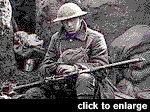 |
 |
Trench Warfare
Trenches had been used in the Crimea, the US Civil War and at the siege of Port Arthur just a decade earlier. But never before had they been dug on such a scale, or used for over four years, as they were on the Western Front. Certainly trenches were never dug in a less suitable place. On much of the war zone the ground was a thin layer of soil over non-porous clay, poor material indeed for digging ditches when combined with the area's heavy rainfall and frequent watercourses.
Water seemed to be everywhere, coming from rain and streams and marshes; it filled each trench like a dyke and was slow to drain away through the clay bottom. Permanently damp at the best of times, trenches could turn into streams from persistent rain, so that men sometimes had to stand up to their knees in water. Soldiers lived here a week or more at a time with little shelter from the weather. Throughout four years of war men were often wet, cold, muddy, sleepless; without proper sanitation or hot food; sometimes suffering from frostbite and trench foot; and distressed by lice, fleas and rats. Added to this was the ever present danger of death: from shellfire, drowning or gas, to name but a few. |

















